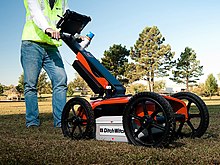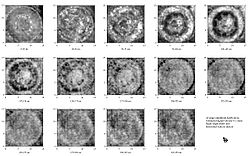Ground-penetrating radar: Difference between revisions
→Similar technologies: cleaned up convoluted ref link |
|||
| Line 47: | Line 47: | ||
==Power regulation== |
==Power regulation== |
||
In 2005, the [[European Telecommunications Standards Institute]] introduced legislation to regulate GPR equipment and GPR operators to control excess emissions of electromagnetic radiation.<ref>ETSI EG 202 730 V1.1.1 (2009–09), "Electromagnetic compatibility and Radio spectrum Matters (ERM); Code of Practice in respect of the control, use and application of Ground Probing Radar (GPR) and Wall Probing Radar (WPR) systems and equipment</ref> The European GPR association (EuroGPR) was formed as a trade association to represent and protect the legitimate use of GPR in Europe. |
In 2005, the [[European Telecommunications Standards Institute]] introduced legislation to regulate GPR equipment and GPR operators to control excess emissions of electromagnetic radiation.<ref>ETSI EG 202 730 V1.1.1 (2009–09), "Electromagnetic compatibility and Radio spectrum Matters (ERM); Code of Practice in respect of the control, use and application of Ground Probing Radar (GPR) and Wall Probing Radar (WPR) systems and equipment</ref> The European GPR association (EuroGPR) was formed as a trade association to represent and protect the legitimate use of GPR in Europe. |
||
u3eyh2oeifhdbhvb hjeebfwejd ejfbhekw sjan bju jks |
|||
==Similar technologies== |
==Similar technologies== |
||
Revision as of 15:37, 22 April 2013

Ground-penetrating radar (GPR) is a geophysical method that uses radar pulses to image the subsurface. This nondestructive method uses electromagnetic radiation in the microwave band (UHF/VHF frequencies) of the radio spectrum, and detects the reflected signals from subsurface structures. GPR can be used in a variety of media, including rock, soil, ice, fresh water, pavements and structures. It can detect objects, changes in material, and voids and cracks.[1]
GPR uses high-frequency (usually polarized) radio waves and transmits into the ground. When the wave hits a buried object or a boundary with different dielectric constants, the receiving antenna records variations in the reflected return signal. The principles involved are similar to reflection seismology, except that electromagnetic energy is used instead of acoustic energy, and reflections appear at boundaries with different dielectric constants instead of acoustic impedances.
The depth range of GPR is limited by the electrical conductivity of the ground, the transmitted center frequency and the radiated power. As conductivity increases, the penetration depth decreases. This is because the electromagnetic energy is more quickly dissipated into heat, causing a loss in signal strength at depth. Higher frequencies do not penetrate as far as lower frequencies, but give better resolution. Optimal depth penetration is achieved in ice where the depth of penetration can achieve several hundred meters. Good penetration is also achieved in dry sandy soils or massive dry materials such as granite, limestone, and concrete where the depth of penetration could be up to 15 m. In moist and/or clay-laden soils and soils with high electrical conductivity, penetration is sometimes only a few centimetres.
Ground-penetrating radar antennas are generally in contact with the ground for the strongest signal strength; however, GPR air-launched antennas can be used above the ground.
Cross borehole GPR has developed within the field of hydrogeophysics to be a valuable means of assessing the presence and amount of soil water.
Applications


GPR has many applications in a number of fields. In the Earth sciences it is used to study bedrock, soils, groundwater, and ice. It is of some utility in prospecting for gold nuggets and for diamonds in alluvial gravel beds, by finding natural traps in buried stream beds that have the potential for accumulating heavier particles.[2]
Engineering applications include nondestructive testing (NDT) of structures and pavements, locating buried structures and utility lines, and studying soils and bedrock. In environmental remediation, GPR is used to define landfills, contaminant plumes, and other remediation sites, while in archaeology it is used for mapping archaeological features and cemeteries. GPR is used in law enforcement for locating clandestine graves and buried evidence. Military uses include detection of mines, unexploded ordnance, and tunnels.
Before 1987 the Frankley Reservoir in Birmingham, England UK was leaking 540 liters of drinking water per second. In that year GPR was used successfully to isolate the leaks.[3]
Borehole radars utilizing GPR are used to map the structures from a borehole in underground mining applications. Modern directional borehole radar systems are able to produce three-dimensional images from measurements in a single borehole.
One of the other main applications for ground penetration radars to locate underground utilities, since GPR is able to generate 3D underground images of pipes, power, sewage and water mains. This technology is often referred to as PAT, short for Pipe Avoiding Tool.
GPR is often used on the channel 4 television program Time Team who use the technology to determine a suitable area for examination by means of excavations. In 1992 GPR was used to recover £150,000 in cash that kidnapper Michael Sams received as a ransom for an estate agent he had kidnapped after Sams buried the money in a field.[4]
Archaeology
Ground penetrating radar survey is one method used in archaeological geophysics. GPR can be used to detect and map subsurface archaeological artifacts, features, and patterning.


The concept of radar is familiar to most people. With ground penetrating radar, the radar signal – an electromagnetic pulse – is directed into the ground. Subsurface objects and stratigraphy (layering) will cause reflections that are picked up by a receiver. The travel time of the reflected signal indicates the depth. Data may be plotted as profiles, as planview maps isolating specific depths, or as three-dimensional models.
GPR can be a powerful tool in favorable conditions (uniform sandy soils are ideal). Like other geophysical methods used in archaeology (and unlike excavation) it can locate artifacts and map features without any risk of damaging them. Among methods used in archaeological geophysics it is unique both in its ability to detect some small objects at relatively great depths, and in its ability to distinguish the depth of anomaly sources. The principal disadvantage of GPR is that it is severely limited by less-than-ideal environmental conditions. Fine-grained sediments (clays and silts) are often problematic because their high electrical conductivity causes loss of signal strength; rocky or heterogeneous sediments scatter the GPR signal, weakening the useful signal while increasing extraneous noise.
Three-dimensional imaging
Individual lines of GPR data represent a sectional (profile) view of the subsurface. Multiple lines of data systematically collected over an area may be used to construct three-dimensional or tomographic images. Data may be presented as three-dimensional blocks, or as horizontal or vertical slices. Horizontal slices (known as "depth slices" or "time slices") are essentially planview maps isolating specific depths. Time-slicing has become standard practice in archaeological applications, because horizontal patterning is often the most important indicator of cultural activities. [5]
Limitations
The most significant performance limitation of GPR is in high-conductivity materials such as clay soils and soils that are salt contaminated. Performance is also limited by signal scattering in heterogeneous conditions (e.g. rocky soils).
Other disadvantages of currently available GPR systems include:
- Interpretation of radargrams is generally non-intuitive to the novice.
- Considerable expertise is necessary to effectively design, conduct, and interpret GPR surveys.
- Relatively high energy consumption can be problematic for extensive field surveys.
Recent advances in GPR hardware and software have done much to ameliorate these disadvantages, and further improvement can be expected with ongoing development.
Power regulation
In 2005, the European Telecommunications Standards Institute introduced legislation to regulate GPR equipment and GPR operators to control excess emissions of electromagnetic radiation.[6] The European GPR association (EuroGPR) was formed as a trade association to represent and protect the legitimate use of GPR in Europe. u3eyh2oeifhdbhvb hjeebfwejd ejfbhekw sjan bju jks
Similar technologies
Ground-penetrating radar uses a variety of technologies to generate the radar signal: these are impulse,[7] stepped frequency, frequency-modulated continuous-wave (FMCW), and noise. Systems on the market in 2009 also use Digital signal processing (DSP) to process the data during survey work rather than off-line.
A special kind of GPR uses unmodulated continuous-wave signals. This holographic subsurface radar differs from other GPR types in that it records plan-view subsurface holograms. Depth penetration of this kind of radar is rather small (20–30 cm), but lateral resolution is enough to discriminate different types of landmines in the soil, or cavities, defects, bugging devices, or other hidden objects in walls, floors, and structural elements.
GPR is used on vehicles for close-in high-speed road survey and landmine detection as well as in stand-off mode.
Pipe-Penetrating Radar (PPR) is an application of GPR technologies applied in-pipe where the signals are directed through pipe and conduit walls to detect pipe wall thickness and voids behind the pipe walls.
Wall-penetrating radar can read through walls and even act as a motion sensor for police.[citation needed]
The "Mineseeker Project" seeks to design a system to determine whether landmines are present in areas using ultra wideband synthetic aperture radar units mounted on blimps.
References
- ^ Daniels DJ (ed.) (2004). Ground Penetrating Radar (2nd ed.). Knoval (Institution of Engineering and Technology). pp. 1–4. ISBN 978-0-86341-360-5.
{{cite book}}:|author=has generic name (help) - ^ Wilson, M. G. C.; Henry, G.; Marshall, T. R. (2006). "A review of the alluvial diamond industry and the gravels of the North West Province, South Africa" (PDF). South African Journal of Geology. 109 (3). Geological Society of South Africa: 301–314. doi:10.2113/gssajg.109.3.301. Retrieved 9 December 2012.
- ^ Penguin Dictionary of Civil Engineering p347 (Radar)
- ^ Birmingham Mail
- ^ Conyers, Lawrence B. And Dean Goodman 1997 Ground Penetrating Radar: An Introduction for Archaeologists. Walnut Creek, CA.: Altamira Press
- ^ ETSI EG 202 730 V1.1.1 (2009–09), "Electromagnetic compatibility and Radio spectrum Matters (ERM); Code of Practice in respect of the control, use and application of Ground Probing Radar (GPR) and Wall Probing Radar (WPR) systems and equipment
- ^ An impulse generator for the ground penetrating radar
- Borchert, Olaf: Receiver Design for a Directional Borehole Radar System Dissertation, University of Wuppertal, 2008, [1]
Further reading
- Conyers, L. B. (2004). Ground-penetrating Radar for Archaeology. Walnut Creek, CA., United States: AltaMira Press Ltd.
A general overview of geophysical methods in archaeology can be found in the following works:
- Clark, Anthony J. (1996). Seeing Beneath the Soil. Prospecting Methods in Archaeology. London, United Kingdom: B.T. Batsford Ltd.
- Gaffney, Chris (2003). Revealing the Buried Past: Geophysics for Archaeologists. Stroud, United Kingdom: Tempus.
{{cite book}}: Unknown parameter|coauthors=ignored (|author=suggested) (help)
